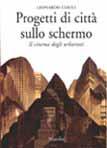urban regeneration conferences special news citizenship housing networks maps Community outskirts & suburbs premio letteratura urbanistica adi fabrication land use identity central places sustainability creativity regulation agriculture urban design conservation & preservation premi tesi di dottorato European policies dottorati digitalization
Progetti di città sullo schermo - Il cinema degli urbanisti - Review
by Giovanni Ginocchini
The study of episodes and circumstances of the city's and of town planning's history founded on the cinematographic sources is the main topic of the research illustrated by this essay.
The premise but, regards the complexity of these documents, not to much considered by the historiography until now: the examination of these sources means in fact, according to the author, to confront the main city's models of modernity in Europe; moreover, the apparently simplicity of these works, hides a communicative will, characteristic of the movie instrument: that one on the screen is much more than a representation of the city, it is, in truth, a precise invite, to the viewers, to the direct experience of the city's models.
After this introduction, the essay presents a reasoned review of the town planners cinema, particularly of the main contributions realised in years Twenty and Fifty of the 1900's, in the United States (The City, New York 1939) and in Europe (Die Stadt von Morgen, Berlin 1930; Neues Banen in Frankfurt am Main, Frankfurt 1928; Pour mieux comprendre Paris, Paris 1935), with an eye particularly careful to the Italian vicissitude (La giornata nella casa popolare, Milano 1933; "QT8". Il quartiere sperimentale modello della ottava Triennale di Milano, Milano 1948; Trilogia, Milano 1954; Comunità millenarie, Milano 1954 e Lucca città comunale, Milano 1955; Città e terre dell'Umbria, Torino 1961).
The review is interlaced with the town planning history of the 1900's, that is here partially illustrated following the chronology of the films, and enriched of interesting cues on the life of some important planners, and, above all, on the relation between the town planners and the media world.
The result is a precise picture of the Cinema's contribution to the discipline, contribution that according to Ciacci, as already said, goes very beyond the representation: these films are real city plans , the sharing of these "media" experiences influences on the behaviours of the citizens and invites them to choose between. constructions and perspectives placed in opposition between them (in fact these movies have been produced in particular periods, the two post-war, in which there was an high listening attitude of the citizens).
According to Ciacci therefore in some moments of the history of the city, it can be taken part in the transformation of the reality and of the organization of the space city also showing new meanings, constructing hypothetical scenes, illustrating plans.
The author, with an original interpretation, invites to re-evaluate these works and opens the debate on the future usefulness of the film (and video) instrument for the urban planning discipline.
This is a review for:
[Book] Progetti di città sullo schermo - Il cinema degli urbanisti
by a cura di Leonardo Ciacci




Planum
The Journal of Urbanism
ISSN 1723-0993
owned by
Istituto Nazionale di Urbanistica
published by
Planum Association
ISSN 1723-0993 | Registered at Court of Rome 4/12/2001, num. 514/2001
Web site realized by ChannelWeb & Planum Association | Powered by BEdita 3

